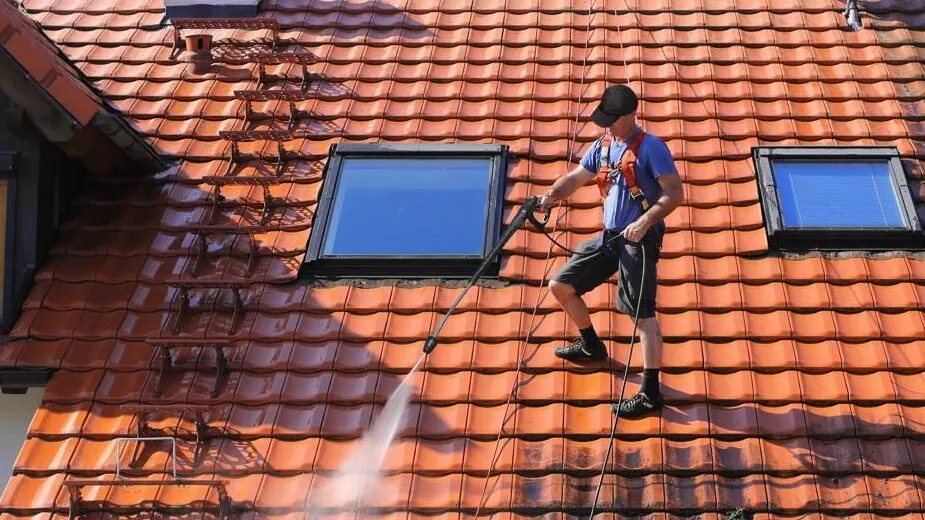
Maintaining a clean roof is a critical aspect of home ownership that often goes overlooked. The roof is the first line of defense against environmental elements, and its condition directly impacts the overall health of the house. Regular maintenance and cleaning of the roof extend its lifespan, improve the home’s curb appeal, and prevent costly repairs.
Roof Cleaning
Neglecting roof maintenance can lead to the accumulation of debris, which can trap moisture and cause rot or mold growth. Over time, this can compromise the structural integrity of the roof. Furthermore, a dirty roof can significantly detract from the aesthetic value of a home, potentially decreasing its market value.
Overview of Roof Cleaning Benefits
Cleaning the roof regularly offers several benefits, both functional and aesthetic. A clean roof ensures proper water drainage, preventing leaks and water damage. It also helps maintain the efficiency of the home’s insulation, as accumulated dirt and debris can affect temperature regulation.
From an aesthetic standpoint, a clean roof enhances the overall look of the house. This is particularly important if you are considering selling your property, as first impressions matter. A well-maintained roof indicates to potential buyers that the home has been cared for, potentially increasing its value.
Additionally, regular roof cleaning can prevent the growth of algae, moss, and lichen, which can cause damage over time. These organisms thrive in moist environments and can deteriorate roofing materials, leading to premature aging. By keeping the roof clean, homeowners can avoid the need for premature replacement, saving both time and money.
In summary, the importance of roof cleaning cannot be overstated. It is an essential part of home maintenance that preserves the roof’s functionality, enhances the home’s appearance, and prevents expensive repairs. In the following sections, we will delve deeper into the specifics of roof cleaning, from understanding different roof types and their cleaning needs to exploring DIY methods and professional services.
Types of Roofs and Their Cleaning Needs
Different Roofing Materials
Roofs come in a variety of materials, each with its unique characteristics and maintenance requirements. Understanding the type of roof you have is essential for determining the appropriate cleaning methods. Here are some common roofing materials:
Asphalt Shingles: The most common roofing material in North America, asphalt shingles are affordable and durable. They can, however, accumulate algae and moss, which can be cleaned using a low-pressure wash and mild detergent.
Metal Roofs: Known for their longevity and resistance to extreme weather conditions, metal roofs can accumulate dirt and debris over time. Cleaning typically involves a gentle wash with a solution designed for metal surfaces to avoid scratching or corrosion.
Tile Roofs: Made from clay, concrete, or slate, tile roofs are heavy and durable. They can attract moss and algae, particularly in humid climates. Cleaning should be done with care to avoid breaking the tiles, usually using a low-pressure washer and a soft brush.
Wood Shingles and Shakes: These provide a natural, rustic look but require more maintenance to prevent mold, mildew, and rot. Cleaning involves gentle washing and the application of a wood-friendly cleaning solution.
Flat Roofs: Often covered with a membrane or built-up roofing, flat roofs require regular debris removal and inspection for ponding water. Cleaning should be done with a low-pressure wash and a gentle scrubbing to avoid damaging the membrane.
Specific Cleaning Requirements for Each Type
As per Happy Clean, a reputable roof cleaner in Dublin, “Different roofing materials necessitate specific cleaning approaches to avoid damage and ensure effective cleaning:
Asphalt Shingles: Use a non-corrosive cleaning solution to avoid stripping the granules that protect the shingles from UV rays. Apply the solution with a low-pressure sprayer, let it sit for a while, then gently rinse off the residue.
Metal Roofs: Avoid using abrasive materials or harsh chemicals that can cause scratches or corrosion. A mild detergent mixed with water and a soft brush or cloth is usually sufficient. For stubborn stains, a specialized metal roof cleaner may be used.
Tile Roofs: Due to the fragility of tiles, use a low-pressure washer and avoid standing on the roof to prevent breakage. Cleaners specifically formulated for tile roofs can help remove algae and moss without damaging the tiles.
Wood Shingles and Shakes: Regular inspection and gentle cleaning are crucial to prevent organic growth. Use a wood-friendly cleaner and a soft brush to scrub the surface, followed by a gentle rinse. Avoid using high pressure, which can erode the wood.
Flat Roofs: Ensure proper drainage to avoid water pooling, which can lead to leaks and structural damage. Regularly remove debris and clean the surface with a low-pressure washer and mild cleaning solution.”
Understanding the specific needs of your roofing material is essential for maintaining its integrity and appearance. Incorrect cleaning methods can cause more harm than good, leading to expensive repairs or replacements. In the next section, we will explore the common types of roof stains and their causes, providing insight into how to address these issues effectively.
Common Roof Stains and Their Causes
Roof stains can significantly detract from the appearance of a home and may indicate underlying issues. Understanding the types of stains that commonly affect roofs is essential for effective cleaning and maintenance:
Algae Stains: Often seen as dark streaks or spots, algae thrive in humid and shaded environments. The most common type, Gloeocapsa magma, feeds on the limestone filler in asphalt shingles, causing discoloration over time.
Moss: Characterized by green, fuzzy patches, moss retains moisture, which can lead to the deterioration of roofing materials. It usually grows in shaded areas where moisture is consistently present.
Lichen: A symbiotic organism composed of algae and fungus, lichen appears as crusty, greenish-gray patches. It can be challenging to remove and may cause significant damage if left untreated.
Mildew and Mold: These fungi thrive in damp environments and appear as black or dark green spots. They can spread quickly and cause health issues if spores enter the home.
Rust Stains: Often seen on metal roofs or where metal fixtures are present, rust stains appear as reddish-brown streaks. These are caused by the oxidation of metal surfaces exposed to moisture.
Factors Contributing to Roof Stains
Several factors can contribute to the development of stains on roofs, and addressing these factors can help prevent future issues:
Humidity and Shade: Roofs in humid climates or heavily shaded areas are more prone to algae, moss, and lichen growth. The consistent presence of moisture provides an ideal environment for these organisms to thrive.
Poor Ventilation: Inadequate roof ventilation can trap heat and moisture, promoting the growth of mold, mildew, and algae. Proper ventilation helps keep the roof dry and reduces the likelihood of staining.
Tree Debris: Overhanging trees can drop leaves, branches, and sap onto the roof, providing nutrients for algae and moss. Additionally, tree shade increases moisture retention on the roof surface.
Roof Material: Certain roofing materials, such as asphalt shingles, are more susceptible to stains due to their composition. For instance, limestone filler in asphalt shingles is a food source for algae.
Lack of Maintenance: Regular roof cleaning and maintenance are essential for preventing stains. Neglecting to clean the roof allows debris and organic matter to accumulate, creating an environment conducive to stain formation.
Environmental Pollutants: Industrial pollution, bird droppings, and airborne particles can settle on the roof, leading to staining over time. Regular cleaning can help mitigate the impact of these pollutants.
Addressing Roof Stains
To effectively address roof stains, it is crucial to identify the type of stain and its underlying cause. Here are some general steps to follow:
Inspection: Conduct a thorough inspection of the roof to identify the type and extent of staining. This helps in determining the appropriate cleaning method.
Cleaning Solution: Use a cleaning solution tailored to the specific type of stain. For algae and moss, a mixture of water and bleach or a specialized roof cleaner can be effective. For rust stains, a rust remover designed for roofing materials may be needed.
Application: Apply the cleaning solution according to the manufacturer’s instructions. For best results, let the solution sit for the recommended time to break down the stain.
Rinsing: Rinse the roof thoroughly with a low-pressure washer to remove the cleaning solution and loosened debris. Avoid high pressure, which can damage the roofing material.
Prevention: Implement preventative measures, such as trimming overhanging branches, improving roof ventilation, and installing zinc or copper strips to inhibit algae growth.

